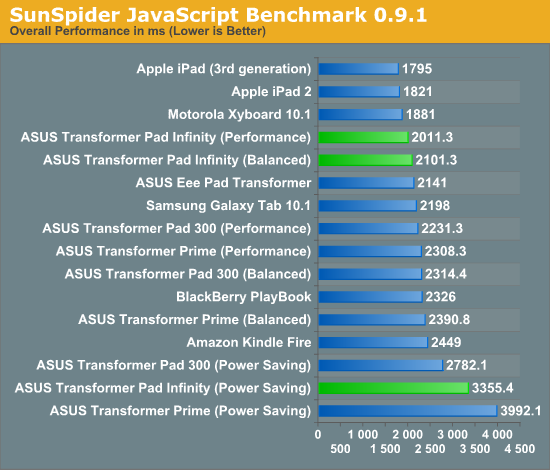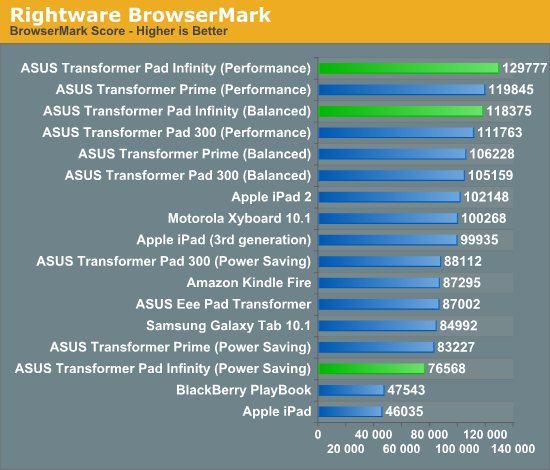ASUS Transformer Pad Infinity (TF700T) Review
by Anand Lal Shimpi on June 25, 2012 3:00 AM ESTA Faster Tegra 3, More Memory Bandwidth
As its new Android tablet flagship, ASUS selected the fastest Tegra 3 SoC NVIDIA is offering today: the T33. Architecturally similar to the rest of the Tegra 3 lineup, the T33 is simply a higher leakage part running at a higher voltage to hit higher clock speeds. Whereas the original T30 used in the Transformer Prime ran at a nominal voltage of 1.15V, the T33 runs at 1.237V. CPU clocks can now reach 1.7GHz with a single core active, or 1.6GHz otherwise.
| NVIDIA Tegra 3 | |||||||
| CPU Cores | Max CPU Clock (1 core active) | Max CPU Clock (multiple cores) | GPU Cores | Max GPU Clock | |||
| NVIDIA Tegra 3 (T33) | 4+1 | 1.7GHz | 1.6GHz | 12 | 520MHz | ||
| NVIDIA Tegra 3 (T30) | 4+1 | 1.4GHz | 1.3GHz | 12 | 520MHz | ||
| NVIDIA Tegra 3 (T30L) | 4+1 | 1.3GHz | 1.2GHz | 12 | 416MHz | ||
ASUS continues to expose control over the CPU governer through its Performance, Balanced and Power Saving modes exposed in ICS. In general, the balanced mode really does deliver nearly max performance (1.5 - 1.6GHz) while power saving significantly clamps CPU clock speeds (1GHz) and is more conservative with ramping up CPU clock to that max. Despite offering support for up to 1.7GHz operation, I typically saw 1.6GHz as a max even in performance mode.


The higher clocked CPU does deliver a tangible performance improvement over the Transformer Prime, and definitely over the original Transformer if you look at the BrowserMark results.
Although GPU clocks remain unchanged, in order to drive the higher resolution panel ASUS outfitted the Infinity with DDR3-1600. If I'm reading the part numbers on the DRAM devices used in previous models it looks like there's a significant increase in memory bandwidth this generation:
| ASUS Transformer Memory Choices | |||||
| TF Prime | TF Pad 300 | TF Pad Infinity | |||
| Memory Capacity | 1GB | 1GB | 1GB | ||
| Memory Type | DDR2-500 | DDR3-667 | DDR3-1600 | ||
| Memory Bandwidth | 2.0GB/s | 2.7GB/s | 6.4GB/s | ||
Remember NVIDIA's Tegra 3 only has a single channel memory interface, so frequency is the only option for increasing memory bandwidth. The increase in bandwidth does make scrolling and most UI interactions fairly smooth, although you will see dropped frames from time to time. I must say I'm fairly impressed by how well ASUS/NVIDIA were able to pull off smoothness without a significant hardware update. It's worth pointing out that the experience is far from perfect though. Even ICS is rough around the edges when it comes to delivering consistent UI performance on a tablet. Google is expected to address this with Jelly Bean but it's something to keep in mind for those buying in the near future. Granted by the time the Infinity is actually available, Jelly Bean may have already launched. As ASUS is widely expected to be a launch partner on Jelly Bean, I wonder if that means TF Pad Infinity owners will get a swift update.










112 Comments
View All Comments
melgross - Monday, June 25, 2012 - link
What a load of bull.ltphilpot - Tuesday, June 26, 2012 - link
Yeah I'm going to call this HOGWASH!!My wife has an orignal iPad and I have an iPad 2. We have never experienced any of the problems that you describe. I freaking hate dishonest trolls, you guys are ridiculous.
If an app has an issue the app shuts down, in 5 years of using iOS I have never had iOS just dump on me! Apps quit and act up.
When someone refers to an iPad as a toy, that's my number one indicator that they have never had one or they just have no clue what they are doing. I work in IT and use my iPad for work to remotely manage servers (when I'm out of the office) and I get plenty of productive business done on it!
Screammit - Tuesday, June 26, 2012 - link
This sounds more like an excuse to carry a toy around, rather than a tool to do more work.DeciusStrabo - Tuesday, June 26, 2012 - link
I had iOS crash on my a couple of times (iPad 2). I don't hold it against it, it's just a tad less stable than my Samsung Galaxy S II on CM9, but it's perfectly useable in this regard, we're talking maybe 4 crashes in a year. Apps (even Apple Apps) crash regularly though. Not annoyingly often, but regularly. Not what I would describe as crash-happy. But also not the mythical "never crashes at all" some people like to claim online.DeciusStrabo - Tuesday, June 26, 2012 - link
I'm one who is looking to jump ship from the (for me personally) too limiting iOS to Android (iPad 2 here). So this tablet looks mighty interesting.Lepton87 - Monday, June 25, 2012 - link
When apple do it- The display is the most gorgeous one I have ever seen. Everything looks painted on. I won't ever look at any display the same.When samsung does it: The text look a little crisper and that's it.
weiran - Monday, June 25, 2012 - link
Look at the comparison yourself, the difference is much smaller compared to the iPad 2 -> 3 transition.Spunjji - Monday, June 25, 2012 - link
That's possibly because the Android devices didn't look quite so much like crap in the first place...EnzoFX - Monday, June 25, 2012 - link
You are so lost if that's really all you got from it. Try reading the articles better.sawilson - Monday, June 25, 2012 - link
You do know that Samsung makes the screen for the iPad 3 right lol. In fact they make 50 percent of the parts in the thing.I own the iPad3. I own the TFP. The colors and brightness and contrast are better on the TFP. The iPad3 is useless outside, and in bright light. The TFP is already a much better tablet than the iPad3. The Infinity just improves on an already industry best design. If you owned both, you'd know it just holding them. Asus makes a much better tablet than apple.